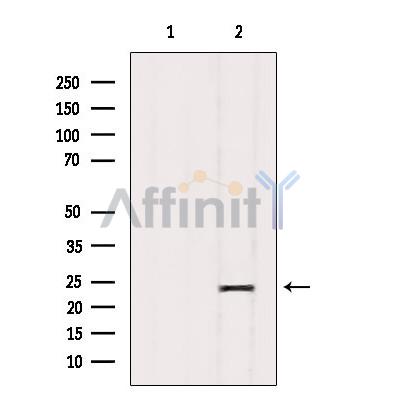ALR Antibody - #DF12110
| Product: | ALR Antibody |
| Catalog: | DF12110 |
| Description: | Rabbit polyclonal antibody to ALR |
| Application: | WB IHC |
| Reactivity: | Human, Mouse, Rat |
| Prediction: | Pig, Zebrafish, Bovine, Horse, Dog, Chicken, Xenopus |
| Mol.Wt.: | 23-25 kDa; 23kD(Calculated). |
| Uniprot: | P55789 |
| RRID: | AB_2844915 |
Related Downloads
Protocols
Product Info
*The optimal dilutions should be determined by the end user. For optimal experimental results, antibody reuse is not recommended.
*Tips:
WB: For western blot detection of denatured protein samples. IHC: For immunohistochemical detection of paraffin sections (IHC-p) or frozen sections (IHC-f) of tissue samples. IF/ICC: For immunofluorescence detection of cell samples. ELISA(peptide): For ELISA detection of antigenic peptide.
Cite Format: Affinity Biosciences Cat# DF12110, RRID:AB_2844915.
Fold/Unfold
ALR_HUMAN; Augmenter of liver regeneration; ERV1; ERV1 homolog; Erv1 like growth factor; FAD-linked sulfhydryl oxidase ALR; GFER; Growth factor augmenter of liver regeneration; Growth factor erv1 like; Hepatic regenerative stimulation substance; Hepatopoietin; Hepatopoietin protein; hERV1; HPO; HPO1; HPO2; HSS;
Immunogens
A synthesized peptide derived from human ALR, corresponding to a region within C-terminal amino acids.
Ubiquitously expressed. Highest expression in the testis and liver and low expression in the muscle.
- P55789 ALR_HUMAN:
- Protein BLAST With
- NCBI/
- ExPASy/
- Uniprot
MAAPGERGRFHGGNLFFLPGGARSEMMDDLATDARGRGAGRRDAAASASTPAQAPTSDSPVAEDASRRRPCRACVDFKTWMRTQQKRDTKFREDCPPDREELGRHSWAVLHTLAAYYPDLPTPEQQQDMAQFIHLFSKFYPCEECAEDLRKRLCRNHPDTRTRACFTQWLCHLHNEVNRKLGKPDFDCSKVDERWRDGWKDGSCD
Predictions
Score>80(red) has high confidence and is suggested to be used for WB detection. *The prediction model is mainly based on the alignment of immunogen sequences, the results are for reference only, not as the basis of quality assurance.
High(score>80) Medium(80>score>50) Low(score<50) No confidence
Research Backgrounds
FAD-dependent sulfhydryl oxidase that regenerates the redox-active disulfide bonds in CHCHD4/MIA40, a chaperone essential for disulfide bond formation and protein folding in the mitochondrial intermembrane space. The reduced form of CHCHD4/MIA40 forms a transient intermolecular disulfide bridge with GFER/ERV1, resulting in regeneration of the essential disulfide bonds in CHCHD4/MIA40, while GFER/ERV1 becomes re-oxidized by donating electrons to cytochrome c or molecular oxygen.
May act as an autocrine hepatotrophic growth factor promoting liver regeneration.
Mitochondrion intermembrane space. Mitochondrion.
Cytoplasm. Secreted.
Ubiquitously expressed. Highest expression in the testis and liver and low expression in the muscle.
Restrictive clause
Affinity Biosciences tests all products strictly. Citations are provided as a resource for additional applications that have not been validated by Affinity Biosciences. Please choose the appropriate format for each application and consult Materials and Methods sections for additional details about the use of any product in these publications.
For Research Use Only.
Not for use in diagnostic or therapeutic procedures. Not for resale. Not for distribution without written consent. Affinity Biosciences will not be held responsible for patent infringement or other violations that may occur with the use of our products. Affinity Biosciences, Affinity Biosciences Logo and all other trademarks are the property of Affinity Biosciences LTD.


